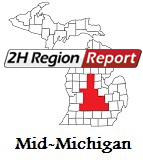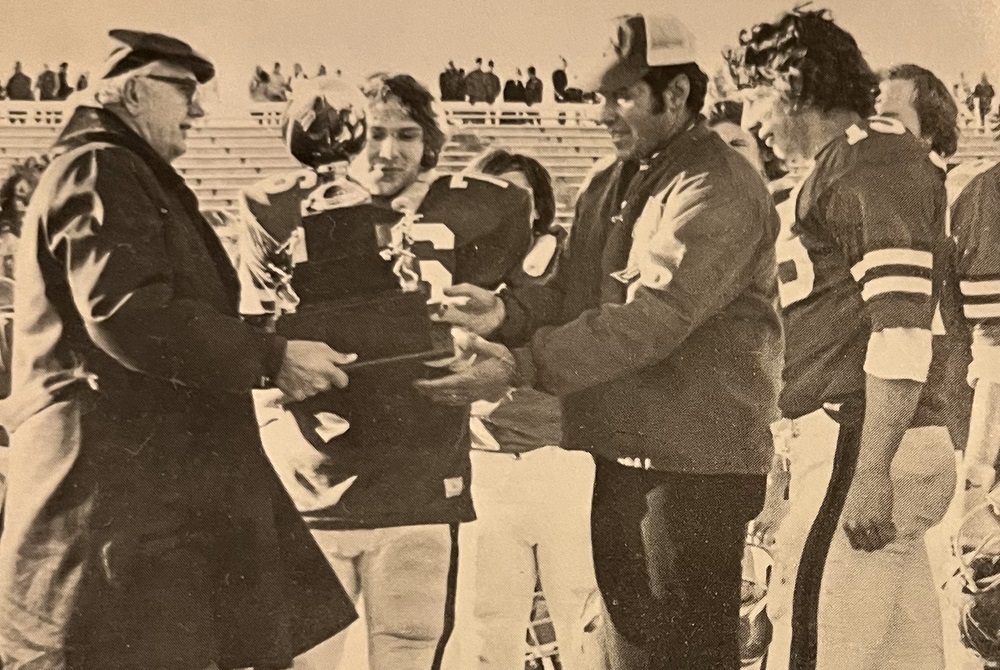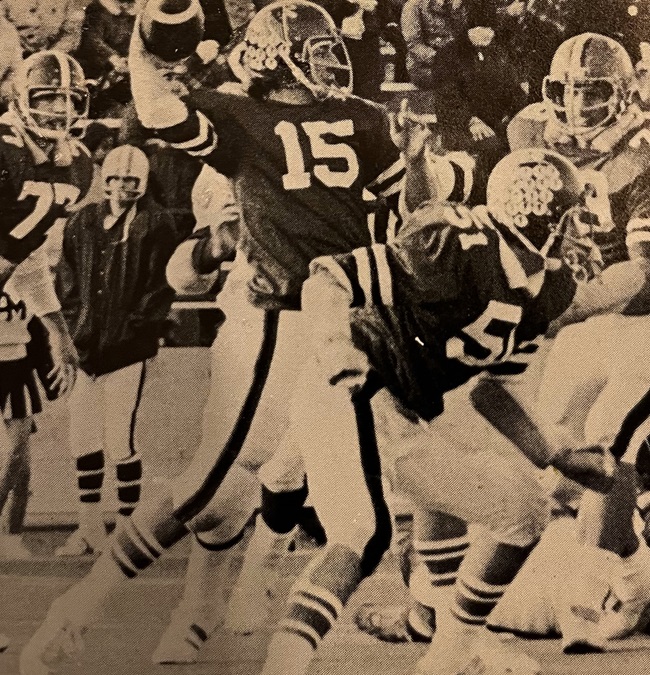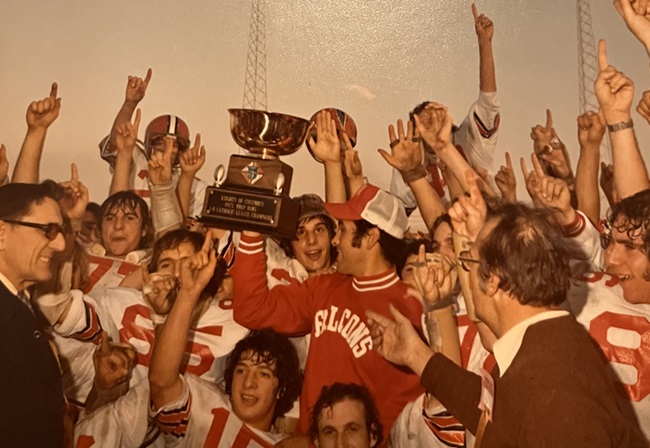
Neighbors Rally, Revive 'Community' Stadium
August 31, 2015
By Geoff Kimmerly
Second Half editor
MOUNT PLEASANT – Josh Wheaton stood admiring the Community Memorial Stadium grass a little less than a year ago, and he knew what was coming next.
The weeks of trampling to come would produce the same result as every year beginning in mid-September.
 “I’m looking at it and thinking, I can’t believe a week ago it was exactly the way you’d want your yard to look,” said Wheaton, a varsity assistant coach for Mount Pleasant’s football team. “And now, it’s this. It’s the same every year. I knew it was coming – and by weeks 7, 8, 9, we were going to be playing in a mud pit.”
“I’m looking at it and thinking, I can’t believe a week ago it was exactly the way you’d want your yard to look,” said Wheaton, a varsity assistant coach for Mount Pleasant’s football team. “And now, it’s this. It’s the same every year. I knew it was coming – and by weeks 7, 8, 9, we were going to be playing in a mud pit.”
But less than a year later, as the team prepared for its first game last week, Wheaton and his Oilers – and co-tenant Mount Pleasant Sacred Heart as well – all were enjoying something that defied any expectation: a project pulled off so quickly, it spoke well to the name of the stadium the schools share.
In less than a year, supporters of Mount Pleasant High and Sacred Heart Academy raised $600,000, secured another $300,000 in donated work, and assisted in the transformation of the stadium from an aging landmark built 50 years ago to what should again be one of mid-Michigan’s athletic jewels for years to come.
The schools reopened the stadium Friday for a doubleheader. Sacred Heart fell to rival Beal City in the opener, and Mount Pleasant then defeated Midland Dow to finish a night that saw more than 5,000 fans pass through the new gates and witness the official debut of stunning two-tone green turf that served as the main focus of a renovation that has only just begun.
“It is a community that believes in young people and certainly believes in athletics,” Mount Pleasant athletic director Jim Conway said. “I think being in a college town (with Central Michigan University), there’s that collegiate portion to it where the kids start (here), and many end up matriculating over there. And we sit right here in the middle of the city, and being the shared facility, that is kind of the focal point. We were able to use that and people latched on and wanted to be a part of it, and we’re still going.”
If you rebuild it …
Community Memorial Stadium opened in 1965 as the shared home of the Mount Pleasant High and Sacred Heart football and track and field programs. Prior to its construction, the programs had a variety of homes – CMU’s Alumni Field for the Oilers and at times the Irish, who also played at Fancher Field and at Island Park going back to at least the mid 1930s.
The new stadium construction was funded solely by the community and opened Sept. 25, 1965, for what ended as a 26-26 tie between Mount Pleasant and East Lansing. The field has remained a point of local pride since, with junior high games and the town’s rocket football teams also taking regular turns on the grass.
 Most weeks during the fall see the stadium host three or four games. But Wheaton said last fall there were three weeks during which 11 games were played.
Most weeks during the fall see the stadium host three or four games. But Wheaton said last fall there were three weeks during which 11 games were played.
It’s not that all the activity tore up the field. But it didn’t allow the grass time to regrow after the older kids did their damage on Fridays and Saturdays.
All of that caused Wheaton to casually suggest last fall to Oilers coach Jason McIntyre that the grass should be replaced with synthetic turf. Never will happen, McIntyre responded. That conversation had been had before – including briefly when a bond was passed eight years ago that led to the repair of the locker rooms, concession stand, press box and track at the stadium – and talks about going to turf had never progressed past the idea stage.
Wheaton told his boss he’d take care of it, but nothing more was said on the topic for a couple weeks … until someone else brought it up, and McIntyre joked that Wheaton was all over it.
This time, he ran with it.
In October, Wheaton formed a committee made up of supporters of both schools. They decided they would need to raise all of the money for turf over six months – by April 1 – and split into sub committees to handle fundraising and construction.
“When I first heard about it, I was a little skeptical,” said Sacred Heart athletic director and football coach Rick Roberts, who like McIntyre is a second-generation football coach in the 26,000-resident town and has led his program for 23 years.
“I wasn’t sure we could raise that much money in that short of a time; the economy isn’t the greatest at the moment. But when I went to a meeting, and saw the energy that was around the table, I knew it was going to happen.”
Pillars of the Community
Mount Pleasant High is a Class A public school with about 1,070 students. Sacred Heart is a Class D Catholic school with about 140 enrolled. In those ways, they couldn’t be more different.
But kids at the schools grow up playing Little League baseball or youth basketball together, and a number of Mount Pleasant High families attend Sacred Heart Parish.
 And there was plenty of work for all to do, and do quickly.
And there was plenty of work for all to do, and do quickly.
With money rolling in, the old grass field would need to be dug out to eight inches below the surface. Materials would need to be brought in to refill the base where the synthetic surface would be laid.
Pennsylvania-based ProGrass did the turf work, but the rest was done with local hands and equipment.
Wheaton made contact with the Isabella County-based Morey Foundation, which pledged to match $200,000 in donations from the community. Committee member Doug Moore is a president with Fisher Companies, which does concrete and asphalt work as well as construction transportation in mid-Michigan, and his company contributed much of the $300,000 in in-kind work.
McGuirk Sand-Gravel, which had also contributed when the stadium originally was built, hauled out the old field, while Malley Construction built the concrete curbs and long jump pits. Contractor Eric Borodychuk constructed the new entrance. Straus Masonry continues to build the wall of bricks and pillars purchased by donors, and other volunteers landscaped the hill near the front gate.
“If you don’t have those kind of people in your community, this doesn’t even get off the ground,” Wheaton said.
“We thought that was there,” Conway said of the support. “This is proof.”
Still work to do
Oilers senior Zach Heeke remembers teammates turning ankles on the old practice fields in holes left over from shot put tosses the previous spring.
Those are more or less a memory now – the varsities for both schools practice daily at the stadium, sometimes splitting the field down the middle. The subvarsity teams still practice on other fields, but the track and field throwing areas are inside the stadium as part of the new construction.
 Heeke is more connected to athletics than a typical high schooler – his dad Dave Heeke is CMU’s athletic director – and Zach appreciates greatly what’s gone into his team’s new home field.
Heeke is more connected to athletics than a typical high schooler – his dad Dave Heeke is CMU’s athletic director – and Zach appreciates greatly what’s gone into his team’s new home field.
“It’s an honor, for sure. It gives us a lot of motivation,” Heeke said. “All the people who donated money to have this happen, we have to show them that we’re good enough and we want to play here, and we’ve got to play for them. It’s awesome to think of all the people who come to our Friday night games, and maybe they’re not showing up in the stands, but they’re on the wall and they’re thinking about us.”
Two members of the original 1965 stadium committee attended a celebration of the new field Thursday. Roberts, who remembers the stadium’s initial construction, believes the original contributors who have since died would be “thrilled” with how the current community has taken up their work and improved upon it.
Bricks and pillars continue to be sold, for as little as $250 and as much as $25,000, as part of the Pillars for the Community fundraising group the renovation committee set up. That money will fund a phase two that likely will include replacing original concrete and possibly adding new bleachers. Both schools are contributing together annually to a fund that will allow for the necessary regular maintenance and then replacement of the turf in 10-12 years.
“(The committee) all wanted the same thing. And when you get a bunch of ex-athletes in a room who all want the same thing for kids in the community, it goes pretty well,” Conway said.
“It’s just been a Mount Pleasant family, if you will."
 Geoff Kimmerly joined the MHSAA as its Media & Content Coordinator in Sept. 2011 after 12 years as Prep Sports Editor of the Lansing State Journal. He has served as Editor of Second Half since its creation in Jan. 2012. Contact him at [email protected] with story ideas for the Barry, Eaton, Ingham, Livingston, Ionia, Clinton, Shiawassee, Gratiot, Isabella, Clare and Montcalm counties.
Geoff Kimmerly joined the MHSAA as its Media & Content Coordinator in Sept. 2011 after 12 years as Prep Sports Editor of the Lansing State Journal. He has served as Editor of Second Half since its creation in Jan. 2012. Contact him at [email protected] with story ideas for the Barry, Eaton, Ingham, Livingston, Ionia, Clinton, Shiawassee, Gratiot, Isabella, Clare and Montcalm counties.
PHOTOS: (Top) The Community Memorial Stadium turf includes the logos of both its home teams, the shamrock for Sacred Heart and the oil derrick for Mount Pleasant High. (Middle top) Supporters have given to the stadium and the schools' players in multiple ways, from buys bricks and pillars to hanging signs. (Middle below) Sacred Heart runs a play against Beal City during Friday's game. (Bottom) Mount Pleasant High and Midland Dow players warm up before their game Friday night.
 A new gate at the north entrance welcomes fans to Mount Pleasant's Community Memorial Stadium. The gate is anchored by pillars highlighting some of the project's largest donors.
A new gate at the north entrance welcomes fans to Mount Pleasant's Community Memorial Stadium. The gate is anchored by pillars highlighting some of the project's largest donors.
 The parking lot-side of the stadium pressbox, like field below, includes banners of both teams that share the field.
The parking lot-side of the stadium pressbox, like field below, includes banners of both teams that share the field.
 The uprights are padded specific to the team on the field; red for Sacred Heart's Irish and dark blue for Mount Pleasant High's Oilers.
The uprights are padded specific to the team on the field; red for Sacred Heart's Irish and dark blue for Mount Pleasant High's Oilers.
 More than 5,000 fans filled the stadium for Friday's doubleheader, these mostly supporters of Mount Pleasant High after the Sacred Heart game against Beal City had ended.
More than 5,000 fans filled the stadium for Friday's doubleheader, these mostly supporters of Mount Pleasant High after the Sacred Heart game against Beal City had ended.

'Refuse to Lose' Divine Child Set Tone for Teams to Come with 1st Class B Title
By
Brad Emons
Special for MHSAA.com
November 15, 2024
There was no more conjecture, no newspaper or Associated Press polls to determine the state football champions.
The champion was no longer decided on paper, but out on the field as the MHSAA launched its first playoff tournament in 1975.
Only 16 total teams over four classes were invited to the dance.
And a school with an already a rich football heritage in Dearborn Divine Child proved it on the field with a 21-0 win over Saginaw MacArthur in the Class B title game before 4,000 fans at Central Michigan University’s Perry Shorts Stadium in Mount Pleasant.
In the Semifinals, MacArthur had outlasted Flint Ainsworth, 44-38, as senior halfback Mark Neiderquill rushed for 285 yards and four touchdowns, while Divine Child ousted Sturgis, 20-3.
In the frigid championship final on Nov. 22, the Falcons’ defense held MacArthur’s high-octane offense to seven first downs and 74 yards rushing. They caused three turnovers, with two fumble recoveries and an interception leading to all three of their TDs.
“I thought we could move the ball, but MacArthur was tough,” DC coach Bob LaPointe told the Detroit Free Press.
In the second quarter, Pat Doyle returned an interception 28 yards for a TD, and Mike Surmacz added the PAT for a 7-0 Divine Child advantage.
 “That first interception really got us rolling,” LaPointe said. “Doyle can run the 40 in 4.9 and speed is what made that touchdown. But he got good blocking, too.”
“That first interception really got us rolling,” LaPointe said. “Doyle can run the 40 in 4.9 and speed is what made that touchdown. But he got good blocking, too.”
Two minutes later, Mike Wiacek gave DC another scoring opportunity when he recovered a MacArthur fumble at the Generals’ 24. Nine plays later, senior quarterback Dan Faletti swept right end and scored on a three-yard bootleg for a 14-0 lead.
“The big thing is that they had a good running back that we had to make sure we kept under control,” said Faletti, who went on to play at Eastern Michigan University before a neck injury prematurely ended his career as a sophomore. “We pretty much got the lead, and Bob was conservative. I just remember scoring that touchdown, and my picture made the paper the next day.”
Neither team could move the ball in the third quarter. There were no first downs.
All-stater Mike Svihra then picked up a fumbled lateral in the fourth quarter and ran 10 yards for the game’s final TD.
“It was not a lot of offense; it was a bitter, cold day,” said Faletti, who went on to work for the Department of Defense for 20 years and Ford Motor Co. before recently retiring. “Bob LaPointe ran a conservative offense. We did ball-control, we didn’t put tons of points on the board ... we didn’t fumble the ball. We didn’t throw interceptions.”
The game, ironically, was played on AstroTurf, not on real grass.
“Everyone makes a bit deal of it, but there really isn’t that much difference,” LaPointe added afterwards. “The only thing I regretted about this game was that I could dress only 44 of my 56 players under the rules. It was tough (to) tell the other 12 they couldn’t suit up.”
An 18-12 loss to Madison Heights Bishop Foley during the final regular-season game, spoiling what would have been an undefeated season in 1974, had left the Falcons distraught – but even more galvanized as they made preparations for the 1975 campaign.
The Falcons also changed their offense in 1975, switching to a triple-option attack that LaPointe got from Notre Dame. The offense proved to be good enough for a 9-0 regular season and an MHSAA playoff berth.
“We were an underdog the whole thing, the whole time, we were the underdog in every big game we played in, but we didn’t allow people to beat us,” said Wes Wishart, who coached the linebackers and offensive line that season before taking over the head coaching reins for the Falcons from 1978-95. “We refused to lose, and that was the motto. From ’74 on those group of kids said, ‘We refuse to lose.’ You use that phrase as a coach all the time, but this group of kids lived it. They were the ones that invented it. When things got tight, ‘refuse, refuse, refuse.’ We’re not backing off from anybody. Great group of young men, great players.”
 During the regular season, DC earned victories over highly-touted Flint Powers Catholic (20-14), previously unbeaten Southgate Aquinas (26-12) and Allen Park Cabrini (12-8).
During the regular season, DC earned victories over highly-touted Flint Powers Catholic (20-14), previously unbeaten Southgate Aquinas (26-12) and Allen Park Cabrini (12-8).
That set up a Catholic League Prep Bowl showdown in the final game of the regular season against highly-touted 8-0 Birmingham Brother Rice, which was ranked No. 1 in the final regular-season AP Class A poll.
Although the Falcons were a decided underdog, the AA division champs upended Rice, 7-0, before a packed crowd at Eastern Michigan University’s Rynearson Stadium to snap the Warriors’ 22-game winning streak thanks to Jim Kempinski’s fumble return for a seven-yard touchdown as he snagged the ball in mid-air and never broke stride while crossing into the end zone.
“We played our butts off,” Faletti said. “It was a dog-eat-dog game.”
It was DC’s 11th Catholic League title, but more importantly put the Falcons into the first MHSAA Playoffs against Sturgis in a Semifinal match at C.W. Post Field in Battle Creek.
“I remember everything was brand new; nobody knew what they were doing,” said Wishart, who guided the Falcons to the 1985 Class A crown as their head coach. “Coach LaPointe on Monday had to get the school to get our hotel rooms in Battle Creek.”
Steve Toepper booted a 27-yard field goal for Sturgis to open the scoring, but DC responded with 20 unanswered points.
In the final quarter, DC’s Rick Rogowski scored on a seven-yard run with 9:23 left (after Steve Savini recovered a fumble caused by Joe Wiercioch) followed by a 10-yard TD run by Faletti with only six minutes to go (after Svihra recovered a fumble).
That sent the Falcons into the Final at CMU, where their defense suffocated MacArthur (9-2).
“We kind of ran a special outside zone. We had to quickly change (how) we would defend that. We shut them down,” said Wishart, who spent 50 years in CYO and high school coaching before retiring to live in New York. “There was no doubt, we were more physical than they were. We were blue collar kids. Typical Divine Child kids, hard-working, never give up.
“We believed desperately in defending Divine Child at all costs because we were a smaller school, so we had an attitude that still lingers there today that we all cultivated. We were going to be a physical squad.”
Meanwhile, what made the Falcons special and unique that title season was their “one for all and all for one” attitude.
“Everybody was the same,” Faletti said. “When we went between the lines, we were all equal. As captain, I got to be command as quarterback in the huddle. But off the field we were all equal. We played like 22 seniors. We were ready for this game.”
PHOTOS (Top) Dearborn Divine Child coaches and players receive the Class B championship trophy after winning the inaugural title game in 1975. (Middle) Falcons quarterback Dan Faletti throws a pass during the Final. (Below) Divine Child players and coaches raise their Prep Bowl trophy in celebration. (Championship game photos courtesy of Dearborn Divine Child yearbook. Prep Bowl photo provided by Dan Faletti.)

